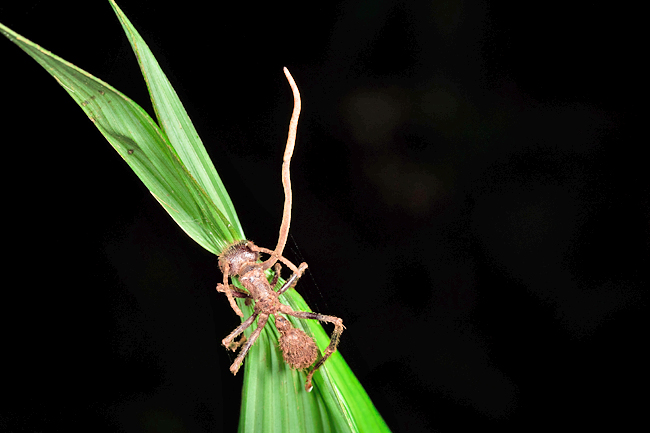Kasha Patel
THE WASHINGTON POST – There’s a new post-apocalyptic zombie video game-turned-HBO series that your distant acquaintances are talking about – and for good reason.
In The Last of Us, a fungus violently infects humans and causes a global pandemic, which sends society into a tailspin and apparently makes for entertaining viewing. Put aside the gore, violence and downfall of human civilisation, and scientists said the show highlights legitimate vulnerabilities.
In a warmer world, fungal infections in people could increase and spread faster than treatments can be developed (although it might not be in a cinematic HBO style). In fact, they already pose a danger to many immunocompromised populations.
“Fungi kill more humans than malaria,” said entomologist David Hughes, who shared his fungal research with creators of the video game the show is based on. “They’re completely overlooked. It’s interesting to get people to think about this.”
Fungi are one the six kingdoms of life. We often picture them as mushrooms, yeasts, lichen – or sometimes even athlete’s foot. They appear like plants but don’t make their own food.
They can gain energy and nutrients by feeding on living hosts, decomposing dead organic matter or by living harmlessly with other organisms.



They may seem like a minor nuisance to the average healthy human, but the kingdom attacks insects and plants in horrifying ways. One type of fungus, for example, eats away at a cicada’s behind and manipulates its wings to attract mates, spreading the fungus like a STD.
The particular fungus that inspired the video game and show, called cordyceps – sometimes referred to as the zombie-ant fungus – causes insects to perch on a branch until the fungus bursts out of its body and releases spores.
People, however, generally don’t experience such graphic, mind-bending encounters with fungi. Most fungi don’t infect people because they can’t withstand our warm body temperature or immune system.
Between 1.5 to five million fungus species may exist in the world, but only a few hundred can make people sick – mostly immunocompromised people, who don’t have a full-strength immune system to fight them off.
In the opening scene of The Last of Us, fictional epidemiologist Dr Neuman challenges these long accepted behaviours of fungi – what if a fungus, say the zombie-ant fungus, could adapt to warmer temperatures and grow in seemingly healthy people? Cue the eerie theme music.
Fungi have been afflicting plants, reptiles and other organisms for millennia. When a giant asteroid hit Earth 66 million years ago, infectious-disease researcher Arturo Casadevall thinks it was a fungal bloom that partly contributed to the decline of reptiles and plants.
The post-calamity environment – with loads of decaying vegetation, darkness and global cooling – likely favoured the growth of fungus, which helped wipe out cold-blooded animals.
Small mammals, who were able to regulate their body temperature, were able to better fend off fungal diseases.
Yet over the past few years, Casadevall has been investigating how climate change could bring new fungal infections to mammals, including people.
“Fungi will adapt to warmer climates by developing greater heat tolerance,” said Casadevall, who is a microbiologist specialising in fungal diseases at Johns Hopkins Bloomberg School of Public Health. “Some will then be able to grow at human temperatures and cause new fungal diseases that we have not seen before.”
For instance, Hughes explained, some fungi could adapt by altering the expression of different proteins that allow them to withstand higher heat. A fungus could also increase their melanin, which would allow them to withstand hotter, drier climates.
“It’s either you adapt to the changing climate, or you go extinct,” said Hughes, who is a professor of global food security at Penn State.
New fungi are already appearing in unexpected places. One fungus called Candida auris, which causes serious infections including in the blood stream, simultaneously emerged on different continents. It has since spread to the United States (US), infecting many COVID-19 patients in hospitals. Certain strains of the fungus are also drug-resistant, making them harder to treat.
Casadevall published a paper comparing the temperature susceptibility of Candida auris with those of its close relatives, suggesting it could be the “first example of a new fungal disease” emerging from modern day climate change.
Fungi, even those that aren’t drug-resistant, are challenging to treat, said physician Julia Koehler. That’s because humans and fungi share many genes, as both evolved from a common ancestor. In fact, fungi are more closely related to animals than they are to plants or bacteria. As a result, a drug that would target a fungus in our bodies could also destroy our surrounding cells.
“That’s why a lot of drugs that were thought perhaps to be useful anti-fungals ended up being eliminated from consideration because they’re toxic in humans, too,” said Koehler, a pediatric infectious-disease specialist at Boston Children’s Hospital. Koehler called for more fungal research funding, saying “a more intense focus on finding better treatments for fungi is very important”.
It wouldn’t take much for a fungus to spread either, said Casadevall. Many fungi move with air currents or can be transported by people or animals.
For instance, a fungus that causes valley fever, which can cause respiratory issues, grows in soil in California and southwestern US. People can get sick just by breathing the dust that contains the fungus. As the climate warms, some computer models project that the area covered by valley fever could more than double by the end of the century.
Now for some good news. Even with all these real concerns about fungi adaptation, treatment and spread, a violent fungi takeover as depicted in The Last of Us is implausible, said Hughes. Specifically, the show creators paint a world where the zombie-ant fungus would enter people’s bodies and control their movements like a “a puppeteer with a marionette”. But Hughes said the zombie-ant fungus has honed that trait for insects, not humans.
“It’s not likely because they have evolved to control precisely the ant’s behaviour, controlling the motor neuron system,” said Hughes. “If they get into humans, they’re not going to be evolved to have that precise control of behaviour.”
That’s not to say the fungus couldn’t affect us in other ways, as many fungi affects our behaviour.
Fungus produces the ethanol in beer, which can make us tipsy and affect our behaviour, said Hughes. In the 19th Century, midwives used to administer a fungus to pregnant people to induce contractions and speed up a delivery. Psychedelics like magic mushrooms and LSD affect the human brain, distorting our senses.
Some fungi even provide benefits to humans. The zombie-ant fungus is actually found in health supplements and used in eye cancer studies to slow tumour growth. Many more fungi live in our body harmlessly and unnoticed.
Plus, if you ask Hughes, humans have a more imminent threat when it comes to climate change: food. Years ago, Hughes hung his hat on researching the zombie-ant fungus and founded PlantVillage, which helps farmers withstand drier climates, pests and other climate-induced hazards in their fields. Some of his work focusses on emerging fungi decimating crops.
“We see lots of examples of plants or animals or microorganisms adapting to increasing temperatures,” said Hughes.
“We shouldn’t expect that the fungi that facilitate our ability to grow food are going to be any different.”







